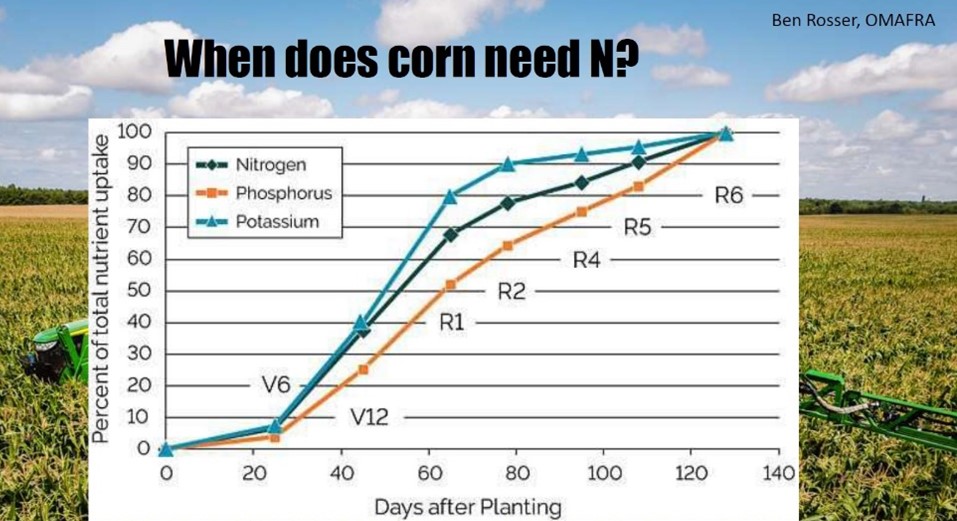Nitrogen (N) dynamics are always complicated, but manure adds a few layers of complexity. Nitrogen availability is impacted by soil texture, soil moisture, organic matter levels in the soil, form of N applied and of course, the weather. An application of liquid finisher hog manure applied ahead of planting would be expected to provide about 20-25 lbs N per 1000 gal for a corn crop.
A corn crop grows quickly and requires about 50% of its nitrogen between early June and August, from the beginning of elongation to just after pollination (Figure 2). The question every year is whether the N from manure will be available in high enough quantity to feed the corn crop, or if there is a need to side-dress some additional commercial nitrogen. N needs later in the season, during grain fill, are often met with the organic N portion of the manure or nitrogen release from previous manure applications

Factors that maximize manure N availability for corn
Manure with high proportion of N as ammonium
• Liquid manure has over half of total N as ammonium N (NH4). Ammonium N is converted to nitrate (NO3) quickly during weather conditions that promote rapid crop growth. Plants can take up ammonium or nitrate N. Organic N is the other portion of manure nitrogen and is a slow-release nitrogen. Nitrogen availability from organic N depends on the carbon to nitrogen ratio (C:N) where the higher the C:N ratio the slower the N release.
• Solid manure has over 75% of the total nitrogen as organic N. Organic N is mineralized by microorganisms in the soil and rate of availability will be affected by the amount of bedding in the manure. The availability to crops of the remaining ammonium portion will depend on timing of application and pH which tends to be high (over 7.6) in solid manure.
Timing of application
• Liquid manure has a higher proportion of nitrogen available to a crop when spring applied
• Solid manure has higher crop available N when fall applied
Incorporation as soon after application as possible
• The ammonium N portion of liquid manure can be lost through volatilization to air. The sooner the manure is incorporated the more ammonium N left for the crop.
• As manure pH increases so does the rate of volatilization. When weather conditions are good for crop growth, the majority of ammonium can be lost on the day of application when manure is not incorporated. Anaerobic digestate often has a high pH and should be injected or incorporated.
Uniformity of application
• It is difficult to give an accurate manure nitrogen credit if the manure has not been applied uniformly to the field.
Manure credits from previous applications
• Where manure has been applied to the same field regularly, there is often a nitrogen credit from the organic N portion for several years after application. This is especially significant with solid manure such as poultry manure where N credit can provide 5-10 lbs N per ton applied.
Weather
• Of course, weather will impact how much nitrogen will be available to a corn crop. When conditions beginning in early May are relatively warm and soil moisture is normal the microbial activity will result in higher N availability compared to cooler, wetter spring conditions. Weather also impacts field conditions. In compacted areas of fields, or areas where ponding occurred there may be higher N losses due to denitrification or restricted root growth.
What about N availability from other manure types?
Manure nutrient content varies from farm to farm. Table 1 provides the typical nitrogen availability for various livestock manures applied to a corn crop based on spring application at pH of about 7 and incorporation within 3 days of application. Fall applied liquid manure will have about half the spring N value while solid manure will have slightly higher N available for the corn.
An actual manure analysis will provide more accurate manure nutrient composition from individual operations.

